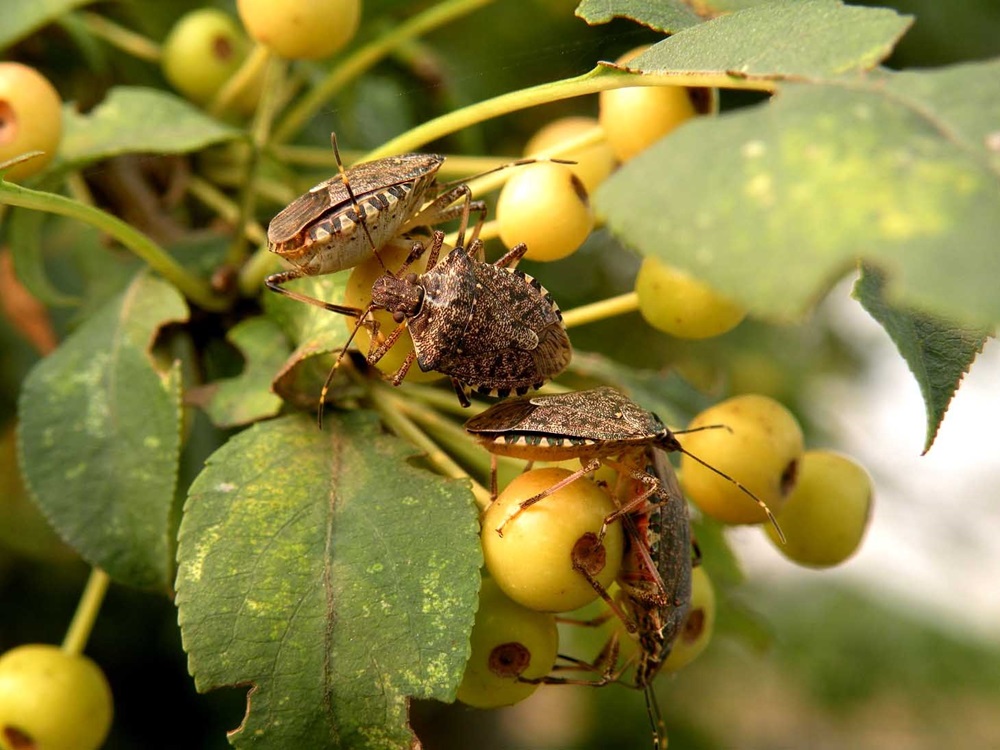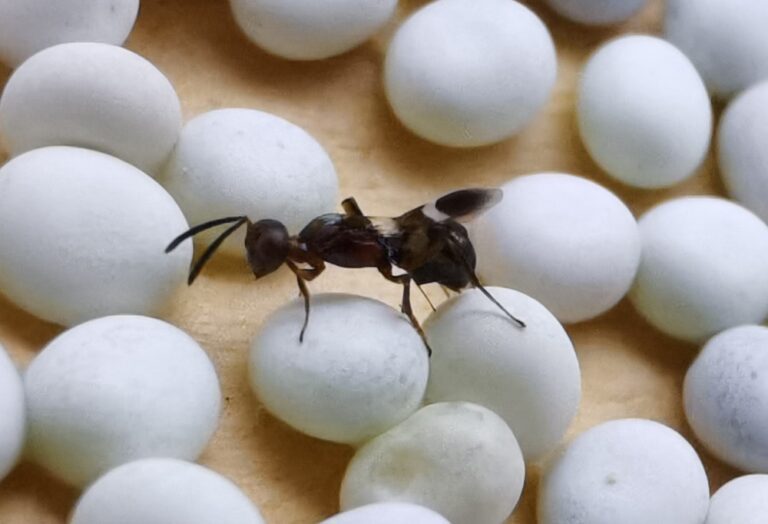
A new study published in the Journal of Economic Entomology has assessed the lethal effects of pesticide residue exposure on beneficial parasitoids and their host the brown marmorated stink bug – a major pest of fruit and nut crops globally.
CABI scientists – including those from the Chinese Ministry of Agriculture and Rural Affairs (MARA)-CABI Joint Laboratory (Joint Lab) – too part in the research which assessed the contact toxicity of residues of eight insecticides against the brown marmorated stink bug (Halyomorpha halys) and three of its main parasitoid species.
These include the biological control agents Anastatus japonicus Ashmead (Hymenoptera: Eupelmidae), Trissolcus japonicus Ashmead (Hymenoptera: Scelionidae), and Trissolcus cultratus Mayr (Hymenoptera: Scelionidae).
Valuable insights for pre-emptive classical biological control
The study aimed to provide valuable insights for pre-emptive classical biological control of the brown marmorated stink bug using these parasitoids. Among the results, it was shown that A. japonicus exhibited higher tolerance to the tested pesticides, while T. japonicus was the most sensitive species.
The brown marmorated stink bug is a global pest which, in 2016, caused $60m worth of damage to Georgia’s hazelnut (a third of its crop) and in 2010, $37m worth of apples were destroyed in parts of the USA.
It is also the kiwifruit industry’s second-most unwanted biosecurity threat after fruit flies and the risk of it entering New Zealand is considered extreme. If it were to enter New Zealand it would have no problem establishing due to New Zealand’s highly suitable climate and abundance of host material. Its entry and establishment would result in significant production impacts to many horticultural industries including kiwifruit.
However, scientists believe that the use of parasitoids – as part of an integrated pest management (IPM) approach – could offer a sustainable way of managing the brown marmorated stink bug that uses both biological and chemical pesticide treatments.

The scientists in the study found that among the pesticides, chlorantraniliprole had the lowest overall impact on all three parasitoid species. Additionally, acetamiprid and azadirachtin were found to be harmless to A. japonicus. Acetamiprid, however, was slightly harmful to T. cultratus. The remaining pesticides showed moderate to significant harmful effects on the parasitoids.
Azadirachtin showed lower overall toxicity to beneficial insects
Azadirachtin showed lower overall toxicity to beneficial insects, suggesting that these materials could be used to manage the brown marmorated stink bug while minimizing harm to key beneficial species.
Dr Jinping Zhang, Senior Project Scientist at CABI and an author of the study, said, “In this study, we found that all commonly used pesticides pose some level of threat to the parasitoids of brown marmorated stink bug, with residual periods longer than 48 hours.
“Therefore, if parasitoid releases are part of the pest management strategy, pesticides should be used as sparingly as possible. It is crucial to select pesticides with the lowest toxicity to brown marmorated stink bugparasitoids, such as acetamiprid.
“Further integration of both chemical pesticides and biological control through parasitoid releases can enhance the effectiveness of IPM programs under field conditions. This approach minimizes the negative impact on natural enemies while effectively managing pest populations.”
Important to assess the compatibility of such approaches
She added that it is important to assess the compatibility of such approaches with other key natural enemies of the brown marmorated stink bug, including other Anastatus and Trissolcus species, which commonly occur in regions invaded by the pest.
The scientists stress that future research should focus on the degradation rates of pesticide residues in real field conditions to determine the optimal spacing between pesticide applications and parasitoid releases. This would ensure the maximum effectiveness of biological control efforts while minimizing harm to natural enemies.
Additional information
Main image: Brown marmorated stink bugs feeding on cherries (Credit: CABI).
Full paper reference
Luo ZY, Gao LP, Li WJ, Chen JH, Ali MY, Zhang F, Li FQ, Wang XP, Zhang JP. Assessing the lethal effects of pesticide residue exposure on beneficial parasitoids and their host, Halyomorpha halys (Stål) (Hemiptera: Pentatomidae). J Econ Entomol. 2025 Feb 11;118(1):242-252. DOI: 10.1093/jee/toae281.
Funding acknowledgement
This work was supported by China’s donation to the CABI Development Fund (VM10051). Feng Zhang and Jinping Zhang received core financial support from CABI and its member countries.
Publications
Haye, T. and Weber, D. (2017) Special issue on the brown marmorated stink bug, Halyomorpha halys: an emerging pest of global concern. Journal of Pest Science.
Stahl, J. et al. (2017) Using the egg parasitoid Anastatus bifasciatus against the invasive brown marmorated stink bug in Europe: can non-target effects be ruled out? Journal of Pest Science.
Zhang, J. et al. (2017) Seasonal parasitism and host specificity of Trissolcus japonicus in northern China. Journal of Pest Science.
Mason, P.G. and Gillespie, D.R. (eds) (2013) Biological Control Programmes in Canada 2001-2012. CABI.
Relevant stories
‘Mass rearing tiny wasps to control the brown marmorated stink bug pest.’
‘Extreme climate change could ‘more than double’ areas suitable for devastating fruit and nut pest.’
Related News & Blogs
Brown marmorated stink bug research in China offers promise to prevent the pest spreading in New Zealand
CABI scientist in China – as part of the Chinese Ministry of Agriculture and Rural Affairs (MARA)-CABI Joint Laboratory (Joint Lab) – are making progress which could help prevent the brown marmorated stink bug spreading in New Zealand. Zespri Internati…
23 May 2023



